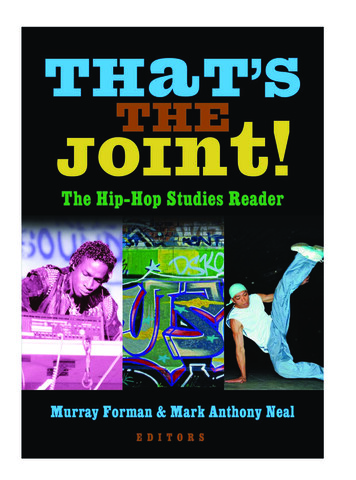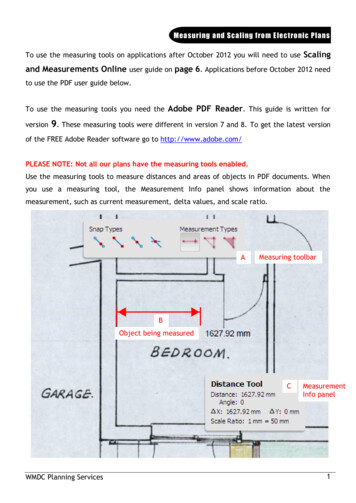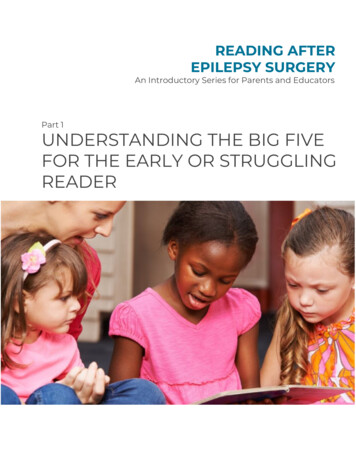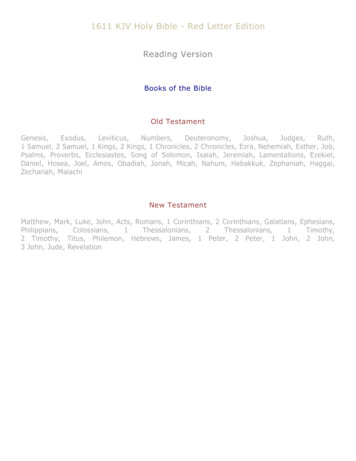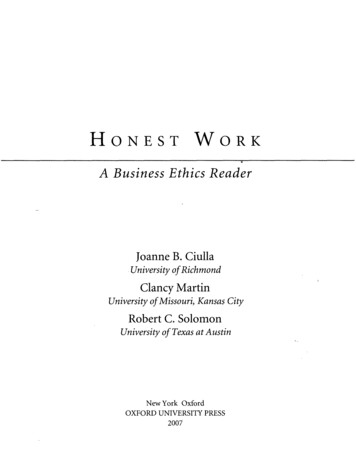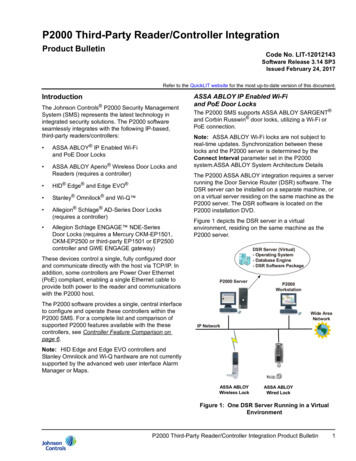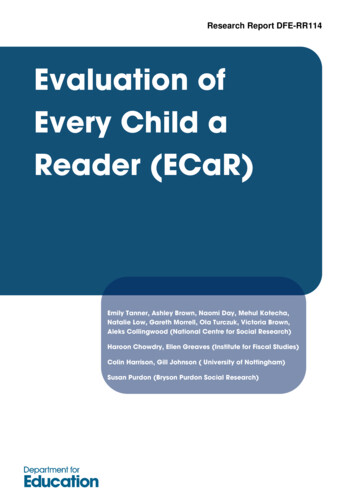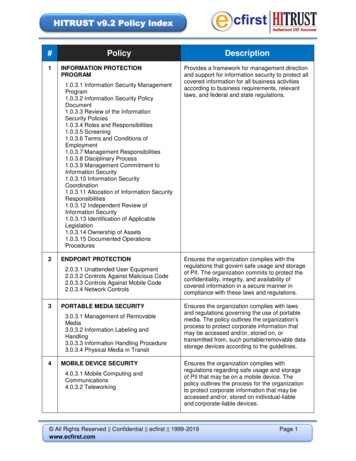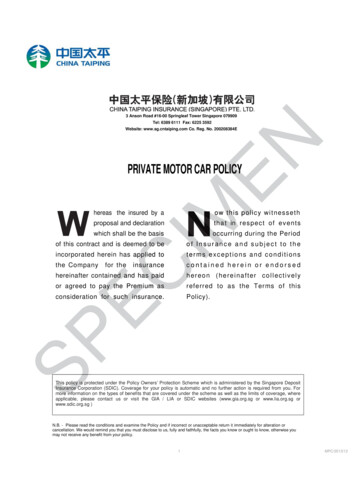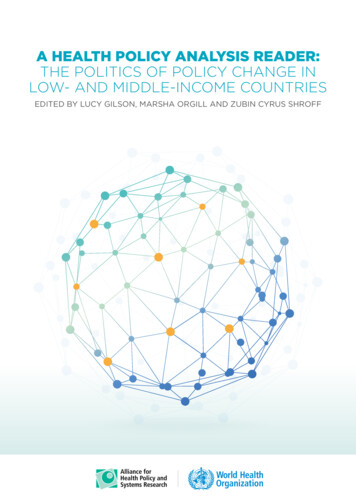
Transcription
A HEALTH POLICY ANALYSIS READER:THE POLITICS OF POLICY CHANGE INLOW- AND MIDDLE-INCOME COUNTRIESEDITED BY LUCY GILSON, MARSHA ORGILL AND ZUBIN CYRUS SHROFF
A HEALTH POLICY ANALYSIS READER:THE POLITICS OF POLICY CHANGE INLOW- AND MIDDLE-INCOME COUNTRIESEDITED BY LUCY GILSON, MARSHA ORGILL AND ZUBIN CYRUS SHROFF
A health policy analysis reader: the politics of policy change in low- and middle-income countries/Lucy Gilson, Marsha Orgill, Zubin Cyrus Shroff, editorsISBN 978-92-4-151451-4 World Health Organization 2018Some rights reserved. This work is available under the Creative Commons Attribution-NonCommercialShareAlike 3.0 IGO licence (CC BY-NC-SA 3.0 IGO; go).Under the terms of this licence, you may copy, redistribute and adapt the work for non-commercialpurposes, provided the work is appropriately cited, as indicated below. In any use of this work, thereshould be no suggestion that WHO endorses any specific organization, products or services. The useof the WHO logo is not permitted. If you adapt the work, then you must license your work under thesame or equivalent Creative Commons licence. If you create a translation of this work, you shouldadd the following disclaimer along with the suggested citation: “This translation was not created bythe World Health Organization (WHO). WHO is not responsible for the content or accuracy of thistranslation. The original English edition shall be the binding and authentic edition”.Any mediation relating to disputes arising under the licence shall be conducted in accordance withthe mediation rules of the World Intellectual Property Organization.Suggested citation. Gilson L, Orgill M, Shroff ZC, editors. A health policy analysis reader: the politicsof policy change in low- and middle-income countries. Geneva: World Health Organization; 2018.Licence: CC BY-NC-SA 3.0 IGO.Cataloguing-in-Publication (CIP) data. CIP data are available at http://apps.who.int/iris.Sales, rights and licensing. To purchase WHO publications, see http://apps.who.int/bookorders.To submit requests for commercial use and queries on rights and licensing, see http://www.who.int/about/licensing.Third-party materials. If you wish to reuse material from this work that is attributed to a third party,such as tables, figures or images, it is your responsibility to determine whether permission is neededfor that reuse and to obtain permission from the copyright holder. The risk of claims resulting frominfringement of any third-party-owned component in the work rests solely with the user.General disclaimers. The designations employed and the presentation of the material in this publicationdo not imply the expression of any opinion whatsoever on the part of WHO concerning the legalstatus of any country, territory, city or area or of its authorities, or concerning the delimitation of itsfrontiers or boundaries. Dotted and dashed lines on maps represent approximate border lines forwhich there may not yet be full agreement.The mention of specific companies or of certain manufacturers’ products does not imply that theyare endorsed or recommended by WHO in preference to others of a similar nature that are notmentioned. Errors and omissions excepted, the names of proprietary products are distinguished byinitial capital letters.All reasonable precautions have been taken by WHO to verify the information contained in thispublication. However, the published material is being distributed without warranty of any kind, eitherexpressed or implied. The responsibility for the interpretation and use of the material lies with thereader. In no event shall WHO be liable for damages arising from its use.The named editors alone are responsible for the views expressed in this publication.Printed in France
CONTENTSPreface 1Foreword 2Contributors 3Acknowledgements 4Introduction 5Lucy GilsonAims and structure of the Reader 5How to use the Reader 6Resources 7Part A. Health policy analysis: starting pointsLucy Gilson, Irene Akua Agyepong and Jeremy ShiffmanWhat is health policy analysis? 10Why does health policy analysis matter? 11Overview: how do health policies emerge and unfold in low- and middle-income countries? 12The political economy of development: explaining policy change 13Policy studies and public administration 15Three concluding thoughts 21Part B. Critical influences over health policy processes in low- and middle‑income countriesB1.Power in policy change 31Lucy Gilson and Jeremy ShiffmanB2.National contexts 37Lucy Gilson and Irene Akua AgyepongB3.Global health actors and national policy-making 45Jeremy Shiffman and Johanna HanefeldPart C. Health policy processes in low- and middle-income countriesC1.National experiences of health policy formulation and policy change 55Lucy Gilson and Irene Akua AgyepongC2.Agenda-setting processes 61Zubin Cyrus Shroff, Johanna Hanefeld and Jeremy ShiffmanC3.Research, evidence and policy change 71Lucy Gilson, Marsha Orgill and Zubin Cyrus ShroffC4.Policy implementation 81Marsha Orgill and Lucy GilsonPart D. Analytical and methodological papersD1.Using health policy analysis prospectively to influence policy change 95Marsha Orgill and Lucy GilsonD2.Methodological issues in health policy analysis research 101Lucy Gilson and Marsha OrgillA Health Policy Analysis Reader for LMICs - iii
Part E. Papers included in the ReaderPart A. Exemplar papersReich, M. R. (1995). The politics of health sector reform in developing countries: three cases ofpharmaceutical policy. Health policy, 32(1‑3), 47‑77 108Walt G, Gilson L (1994). Reforming the health sector in developing countries: the central role ofpolicy analysis. Health Policy Plan. 9:353–70 109Part B. Exemplar papersB1Dalglish S, Surkan P, Diarra A, Harouna A, Bennett S (2015). Power and pro-poor policies: the caseof iCCM in Niger. Health Policy Plan. 30(Suppl 2):ii84-ii94 110Gilson L, Schneider H, Orgill M (2014). Practice and power: a review and interpretive synthesisfocused on the exercise of discretionary power in policy implementation by frontline providers andmanagers. Health Policy Plan. 29(Suppl 3):iii51-iii69 111B2Carbone G (2011). Democratic demands and social policies: the politics of health reform in Ghana.J Mod Afr Stud. 49(03):381-408 112Olivier de Sardan JP (2011). The eight modes of local governance in West Africa. IDS Bull. 42(2):22-31 113B3Hawkins B, Holden C (2016). A corporate veto on health policy? Global constitutionalism andinvestor-state dispute settlement. J Health Polit Policy Law. 41(5):969-95 114Ogden J, Walt G, Lush L (2003). The politics of “branding” in policy transfer: the case of DOTS fortuberculosis control. Soc Sci Med. 57(1), 179-88 115Part C. Exemplar papersC1Berlan D, Buse K, Shiffman J, Tanaka S (2014). The bit in the middle: a synthesis of global healthliterature on policy formulation and adoption. Health Policy Plan. 29(Suppl3):iii23-34 116Shearer JC, Abelson J, Kouyate B, Lavis JN, Walt G (2016). Why do policies change? Institutions,interests, ideas and networks in three cases of policy reform. Health Policy Plan. 31(9):1200-11 117C2Shiffman J, Stanton C, Salazar AP (2004). The emergence of political priority for safe motherhoodin Honduras. Health Policy Plan. 19(6):380-90 118Walt G, Gilson L (2014). Can frameworks inform knowledge about health policy processes?Reviewing health policy papers on agenda-setting and testing them against a specific prioritysetting framework. Health Policy Plan. 29(suppl 3):iii6-iii22 119C3Hawkins B, Parkhurst J (2016). The “good governance” of evidence in health policy. Evid Policy.12(4): 575-92 120Ongolo-Zogo P, Lavis JN, Tomson G, Sewankambo NK (2018). Assessing the influence ofknowledge translation platforms on health system policy processes to achieve the healthmillennium development goals in Cameroon and Uganda: a comparative case study. Health PolicyPlan. 33(4):539-54 121C4Erasmus E, Orgill M, Schneider H, Gilson L (2014). Mapping the existing body of health policyimplementation research in lower income settings: what is covered and what are the gaps? HealthPolicy Plan. 29(Suppl 3):iii35-iii50 122Walker L, Gilson L (2004). ‘We are bitter but we are satisfied’: nurses as street-level bureaucrats inSouth Africa. Soc Sci Med. 59:1251-61 123Part D. Exemplar papersD1Buse K, Lalji N, Mayhew SH, Imran M, Hawkes S (2009). Political feasibility of scaling-up fiveevidence-informed HIV interventions in Pakistan: a policy analysis. Sex Transm Infect. 85 (Suppl II) 124iv - 2018
Makan A, Fekadu A, Murhar V, Luitel N, Kathree T, Ssebunya J et al. (2015). Stakeholder analysisof the Programme for Improving Mental health carE (PRIME): baseline findings. Int J Ment HealthSyst. 9:27 125D2Bowen GA (2009). Document analysis as a qualitative research method. Qual Res. 9(2):27-40 126Walt G, Shiffman J, Schneider H, Murray SF, Brugha R, Gilson L (2008). ‘Doing’ health policyanalysis: methodological and conceptual reflections and challenges. Health Policy Plan. 23(5):308-17 127Additional papersPart AGrindle MS, Thomas JW (1989). Policy makers, policy choices, and policy outcomes: the politicaleconomy of reform in developing countries. Policy Sci. 22(3-4):213-48 130Part BB1Hyden G (2006). Beyond governance: bringing power into policy analysis. Forum Dev Stud.33(2):215-36 131Koduah A, Agyepong IA, van Dijk H (2016). “The one with the purse makes policy”: power, problemdefinition, framing and maternal health policies and programmes evolution in national levelinstitutionalised policy making processes in Ghana. Soc Sci Med. 167:79-87 132B2Smith SL (2014). Political contexts and maternal health policy: insights from a comparison of southIndian states. Soc Sci Med. 100:46-53 133Steytler N (2003). Federal homogeneity from the bottom-up: provincial shaping of national HIV/AIDS policy in South Africa. Publius. 33(1):59-74 134B3Hanefeld J (2010). The impact of global health initiatives at national and sub-national level – apolicy analysis of their role in implementation processes of antiretroviral treatment (ART) rollout inZambia and South Africa. AIDS Care. 22(sup1):93-102 135Kaufman J (2012). China’s evolving AIDS policy: the influence of global norms and transnationalnon-governmental organizations. Contemp Politics. 18(2):225-38 136Part CC1Lim S, Lee KH, Suh HS, Bae KH (2014). To whom do bureaucrats need to respond? Two faces ofcivil society in health policy. Soc Sci Med. 123:269-77 137C3Gilson L, McIntyre D (2008). The interface between research and policy: experience from SouthAfrica. Soc Sci Med. 67(5):748-59 138Sumner A, Harpham T (2008). The market for “evidence” in policy processes: the case of childhealth policy in Andhra Pradesh, India and Viet Nam. Eur J Dev Res. 20(4):712-32 139Part DD1Chapman J, Fisher T (2000). The effectiveness of NGO campaigning: lessons from pract
If you adapt the work, then you must license your work under the same or equivalent Creative Commons licence. If you create a translation of this work, you should add the following disclaimer along with the suggested citation: “This translation was not created by the World Health Organization (WHO). WHO is not responsible for the content or accuracy of this translation. The original English .
